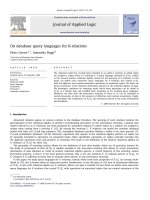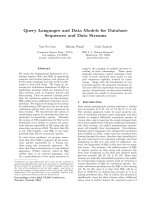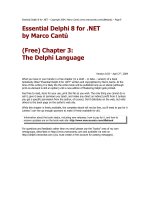SQL the query language
Bạn đang xem bản rút gọn của tài liệu. Xem và tải ngay bản đầy đủ của tài liệu tại đây (2.45 MB, 58 trang )
SQL: The Query
Language
CS 186, Spring 2006,
Lectures 11&12
R &G - Chapter 5
Life is just a bowl of queries.
-Anon
Administrivia
•
Midterm1 was a bit easier than I wanted it to be.
–
Mean was 80
–
Three people got 100(!)
–
I’m actually quite pleased.
–
But, I do plan to “kick it up a notch” for the future exams.
•
Be sure to register your name with your cs186 login if
you haven’t already else, you risk not getting grades.
•
Homework 2 is being released today.
–
Today and Tuesday’s lectures provide background.
–
Hw 2 is due Tuesday 3/14
–
It’s more involved than HW 1.
Relational Query Languages
•
A major strength of the relational model:
supports simple, powerful
querying
of data.
•
Two sublanguages:
•
DDL – Data Defn Language
–
define and modify schema (at all 3 levels)
•
DML – Data Manipulation Language
–
Queries can be written intuitively.
•
The DBMS is responsible for efficient evaluation.
–
The key: precise semantics for relational queries.
–
Allows the optimizer to extensively re-order
operations, and still ensure that the answer does
not change.
–
Internal cost model drives use of indexes and
choice of access paths and physical operators.
The SQL Query Language
•
The most widely used relational query language.
•
Originally IBM, then ANSI in 1986
•
Current standard is SQL-2003
•
Introduced XML features, window functions,
sequences, auto-generated IDs.
•
Not fully supported yet
•
SQL-1999 Introduced “Object-Relational”
concepts. Also not fully suppored yet.
•
SQL92 is a basic subset
•
Most systems support a medium
•
PostgreSQL has some “unique” aspects (as do
most systems).
The SQL DML
•
Single-table queries are straightforward.
•
To find all 18 year old students, we can write:
SELECT *
FROM Students S
WHERE S.age=18
•
To find just names and logins, replace the first line:
SELECT S.name, S.login
QuickTime™ and a
TIFF (LZW) decompressor
are needed to see this picture.
Querying Multiple Relations
•
Can specify a join over two tables as follows:
SELECT S.name, E.cid
FROM Students S, Enrolled E
WHERE S.sid=E.sid AND E.grade=‘B'
result =
S.name E.cid
Jones History105
QuickTime™ and a
TIFF (LZW) decompressor
are needed to see this picture.
Note: obviously no
referential integrity
constraints have
been used here.
Basic SQL Query
•
relation-list
: A list of relation names
–
possibly with a
range-variable
after each name
•
target-list
: A list of attributes of tables in
relation-list
•
qualification
: Comparisons combined using AND, OR
and NOT.
–
Comparisons are Attr
op
const or Attr1
op
Attr2,
where
op
is one of =≠<>≤≥
•
DISTINCT
: optional keyword indicating that the answer should
not contain duplicates.
–
In SQL SELECT, the default is that duplicates are
not
eliminated! (Result is called a “multiset”)
SELECT [DISTINCT] target-list
FROM relation-list
WHERE qualification
•
Semantics of an SQL query are defined in terms of
the following conceptual evaluation strategy:
1. do FROM clause: compute
cross-product
of
tables (e.g., Students and Enrolled).
2. do WHERE clause: Check conditions, discard
tuples that fail. (i.e., “selection”).
3. do SELECT clause: Delete unwanted fields.
(i.e., “projection”).
4. If DISTINCT specified, eliminate duplicate rows.
Probably the least efficient way to compute a query!
–
An optimizer will find more efficient strategies to
get the
same answer
.
Query Semantics
Cross Product
SELECT S.name, E.cid
FROM Students S, Enrolled E
WHERE S.sid=E.sid AND E.grade=‘B'
QuickTime™ and a
TIFF (LZW) decompressor
are needed to see this picture.
QuickTime™ and a
TIFF (LZW) decompressor
are needed to see this picture.
QuickTime™ and a
TIFF (LZW) decompressor
are needed to see this picture.
QuickTime™ and a
TIFF (LZW) decompressor
are needed to see this picture.
Step 2) Discard tuples that fail predicate
SELECT S.name, E.cid
FROM Students S, Enrolled E
WHERE S.sid=E.sid AND E.grade=‘B'
QuickTime™ and a
TIFF (LZW) decompressor
are needed to see this picture.
Step 3) Discard Unwanted Columns
SELECT S.name, E.cid
FROM Students S, Enrolled E
WHERE S.sid=E.sid AND E.grade=‘B'
Now the Details
Reserves
Sailors
Boats
We will use these
instances of
relations in our
examples.
bid
bname
color
101
Interlake
blue
102
Interlake
red
103
Clipper
green
104
Marine
red
sid
sname
rating
age
22
Dustin
7
45.0
31
Lubber
8
55.5
95
Bob
3
63.5
sid
bid
day
22
101
10/10/96
95
103
11/12/96
Example Schemas (in SQL DDL)
CREATE TABLE Sailors (sid INTEGER,
sname CHAR(20),rating INTEGER,
age REAL,
PRIMARY KEY sid)
CREATE TABLE Boats (bid INTEGER,
bname CHAR (20), color CHAR(10)
PRIMARY KEY bid)
CREATE TABLE Reserves (sid INTEGER,
bid INTEGER, day DATE,
PRIMARY KEY (sid, bid, date),
FOREIGN KEY sid REFERENCES Sailors,
FOREIGN KEY bid REFERENCES Boats)
Another Join Query
SELECT sname
FROM Sailors, Reserves
WHERE Sailors.sid=Reserves.sid
AND bid=103
(sid)
sname
rating
age
(sid)
bid
day
22
dustin
7
45.0
22
101
10/10 / 96
22
dustin
7
45.0
58
103
11/12 / 96
31
lubber
8
55.5
22
101
10/10 / 96
31
lubber
8
55.5
58
103
11/12 / 96
95
Bob
3
63.5
22
101
10/10 / 96
95
Bob
3
63.5
95
103
11/12 / 96
Some Notes on Range Variables
•
Can associate “range variables” with the tables in
the FROM clause.
–
saves writing, makes queries easier to understand
•
Needed when ambiguity could arise.
–
for example, if same table used multiple times in
same FROM (called a “self-join”)
SELECT S.sname
FROM Sailors S, Reserves R
WHERE S.sid=R.sid AND bid=103
SELECT sname
FROM Sailors,Reserves
WHERE Sailors.sid=Reserves.sid AND bid=103
Can be
rewritten using
range variables as:
More Notes
•
Here’s an example where range variables are
required (self-join example):
•
Note that target list can be replaced by “*” if
you don’t want to do a projection:
SELECT x.sname, x.age, y.sname, y.age
FROM Sailors x, Sailors y
WHERE x.age > y.age
SELECT *
FROM Sailors x
WHERE x.age > 20
Find sailors who’ve reserved at least one
boat
•
Would adding DISTINCT to this query make a
difference?
•
What is the effect of replacing
S.sid
by
S.sname
in the SELECT clause?
–
Would adding DISTINCT to this variant of the query
make a difference?
SELECT S.sid
FROM Sailors S, Reserves R
WHERE S.sid=R.sid
Expressions
•
Can use arithmetic expressions in SELECT clause
(plus other operations we’ll discuss later)
•
Use AS to provide column names
•
Can also have expressions in WHERE clause:
SELECT S.age, S.age-5 AS age1, 2*S.age AS age2
FROM Sailors S
WHERE S.sname = ‘dustin’
SELECT S1.sname AS name1, S2.sname AS name2
FROM Sailors S1, Sailors S2
WHERE 2*S1.rating = S2.rating - 1
String operations
`_’ stands for any one character and `%’ stands for
0 or more arbitrary characters.
SELECT S.age, age1=S.age-5, 2*S.age AS age2
FROM Sailors S
WHERE S.sname LIKE ‘B_%B’
•
SQL also supports some string operations
•
“LIKE” is used for string matching.
Find sid’s of sailors who’ve reserved a red or a green boat
•
UNION: Can be used to compute the union of any
two
union-compatible
sets of tuples (which are
themselves the result of SQL queries).
SELECT DISTINCT R.sid
FROM Boats B,Reserves R
WHERE R.bid=B.bid AND
(B.color=‘red’OR B.color=‘green’)
SELECT R.sid
FROM Boats B, Reserves R
WHERE R.bid=B.bid AND B.color=‘red’
UNION SELECT R.sid
FROM Boats B, Reserves R
WHERE R.bid=B.bid AND
B.color=‘green’
Vs.
(note:
UNION
eliminates
duplicates
by default.
Override w/
UNION ALL)
SELECT R.sid
FROM Boats B,Reserves R
WHERE R.bid=B.bid AND
(B.color=‘red’ AND B.color=‘green’)
Find sid’s of sailors who’ve reserved a red and a green
boat
•
If we simply replace OR by AND in the previous
query, we get the wrong answer. (Why?)
•
Instead, could use a self-join:
SELECT R1.sid
FROM Boats B1, Reserves R1,
Boats B2, Reserves R2
WHERE R1.sid=R2.sid
AND R1.bid=B1.bid
AND R2.bid=B2.bid
AND (B1.color=‘red’ AND
B2.color=‘green’)
AND Continued…
•
INTERSECT:discussed in
book. Can be used to
compute the
intersection of any two
union-compatible
sets of
tuples.
•
Also in text: EXCEPT
(sometimes called MINUS)
•
Included in the SQL/92
standard, but many
systems don’t support
them.
SELECT S.sid
FROM Sailors S, Boats B,
Reserves R
WHERE S.sid=R.sid
AND R.bid=B.bid
AND B.color=‘red’
INTERSECT
SELECT S.sid
FROM Sailors S, Boats B,
Reserves R
WHERE S.sid=R.sid
AND R.bid=B.bid
AND B.color=‘green’
Key field!
Nested Queries
•
Powerful feature of SQL: WHERE clause can itself
contain an SQL query!
–
Actually, so can FROM and HAVING clauses.
•
To find sailors who’ve
not
reserved #103, use NOT IN.
•
To understand semantics of nested queries:
–
think of a
nested loops
evaluation:
For each Sailors tuple,
check the qualification by computing the subquery.
SELECT S.sname
FROM Sailors S
WHERE S.sid IN (SELECT R.sid
FROM Reserves R
WHERE R.bid=103)
Names of sailors who’ve reserved boat #103:
Nested Queries with Correlation
•
EXISTS is another set comparison operator, like IN.
•
Can also specify NOT EXISTS
•
If UNIQUE is used, and * is replaced by
R.bid
, finds
sailors with at most one reservation for boat #103.
–
UNIQUE checks for duplicate tuples in a subquery;
•
Subquery must be recomputed for each Sailors tuple.
–
Think of subquery as a function call that runs a query!
SELECT S.sname
FROM Sailors S
WHERE EXISTS (SELECT *
FROM Reserves R
WHERE R.bid=103 AND S.sid=R.sid)
Find names of sailors who’ve reserved boat #103:
More on Set-Comparison Operators
•
We’ve already seen IN, EXISTS and UNIQUE. Can also use
NOT IN, NOT EXISTS and NOT UNIQUE.
•
Also available:
op
ANY,
op
ALL
•
Find sailors whose rating is greater than that of some
sailor called Horatio:
SELECT *
FROM Sailors S
WHERE S.rating > ANY (SELECT S2.rating
FROM Sailors S2
WHERE S2.sname=‘Horatio’)









![the japanese language - h. kindaichi (tuttle, 1978) [ecv] ww](https://media.store123doc.com/images/document/14/y/yi/medium_t0PW57OFko.jpg)